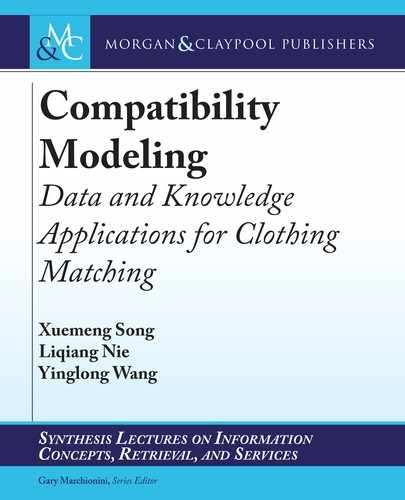3.5. SUMMARY 25
To obtain more detailed insights, apart from the overall comparative evaluation, we further
checked the performance of the proposed models on the seven most popular top categories. As
can be seen from Figure 3.6, BPR-DAE still consistently shows superiority over both BPR-
DAE-V and BPR-DAE-C on each of the seven top categories. Meanwhile, we found that
contextual information significantly improves the performance on top categories such as “Jacket”
and “Coat,” compared to “T-shirt” and “Cardigan” categories. One possible explanation is that
the matching for coats and jackets would be more complicated [19] due to the fact that they
serve people in more seasons and thus apart from the common color and pattern factors, we also
need further consider other factors such as various material (e.g., silk, wool, fur, and leather)
and length (e.g., long, medium, and short). ese factors may not be easy-learned from visual
signals but can be effectively captured by contextual information. On the contrary, pertaining to
tops of basic style categories, such as T-shirts and cardigans, where color and shape factors play
more important roles in clothing matching, visual signals are more powerful than the context.
3.4.6 ON COMPLEMENTARY FASHION ITEM RETRIEVAL
To efficiently evaluate the proposed BPR-DAE toward the complementary fashion item re-
trieval, we adopted the common strategy [37, 59] that feeds each top t
i
appeared in S
test
as a
query, and randomly selects T bottoms as the candidates, where there is only one positive can-
didate. en by passing them to the neural networks trained by S
train
and S
valid
, getting their
latent representations and calculating the compatibility score m
ij
according to Eq. (3.3), we can
generate a ranking list of these bottoms for the given top. In our setting, we care about the
average position of the positive bottom in the ranking list and thus adopt the mean reciprocal
rank (MRR) metric [52], which provides insights into the ability to return the positive bottoms
at the top of the rankings. In total, we have 1,954 unique tops in the testing set, among which
1,262 tops have never appeared in S
train
or S
valid
.
Figure 3.8 shows the performance of different models in terms of MRR at different num-
bers of the bottom candidates T . It is worth mentioning that we dropped the POP baseline
here due to the fact that the majority of tops share the same popularity of 1, which makes it in-
tractable to generate the ranking. As can be seen, our model shows superiority over all the other
baselines consistently at different numbers of bottom candidates, which verifies the effectiveness
of our model in complementary fashion item retrieval and coping with the cold start problem.
Certain intuitive ranking results for testing tops can be found in Figure 3.9. We noticed that
although BPR-DAE sometimes failed to accurately rank the positive bottom at the first place,
the neutral bottoms ranked before the positive one are also compatible with the given top, which
is reasonable in the real application.
3.5 SUMMARY
In this chapter, we present a content-based neural scheme (BPR-DAE) for compatibility mod-
eling toward clothing matching (i.e., matching the tops and bottoms), which is able to jointly

26 3. DATA-DRIVEN COMPATIBILITY MODELING
0.25
0.20
0.15
0.10
0.05
0.00
10 20 30 40 50 60 70 80 90 100
T
MRR
BPR-DAE
ExIBR
IBR
RAW
RAND
Figure 3.8: Performance of different models with respect to MRR at different numbers of the
bottom candidates T .
Query 1 2 3 4 5 6 7 8 9 10
Figure 3.9: Illustration of the ranking results for given testing tops. e bottoms highlighted in
the red boxes are the positive ones.
model the coherent relationship between different modalities of fashion items and the implicit
preference among items via a dual autoencoder network. Experimental results demonstrate the
effectiveness of our proposed scheme and verify the advantages of taking the contextual modality
into consideration in terms of compatibility modeling. Surprisingly, we found that contextual
modality even shows superiority over the visual modality, especially toward complicated tops
(e.g., coats) rather than the basic ones (e.g., T-shirts). Currently, we fail to explore the cate-
gory hierarchy to further enhance the compatibility modeling, which can be the future work
direction.
..................Content has been hidden....................
You can't read the all page of ebook, please click here login for view all page.
